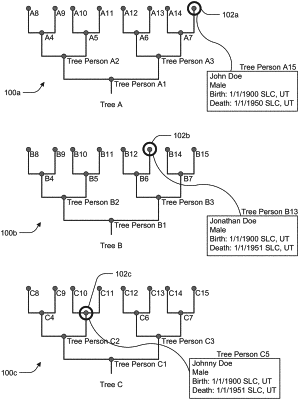| CPC G06F 16/9027 (2019.01) [G06F 18/2113 (2023.01); G06F 18/2148 (2023.01); G06F 18/2178 (2023.01); G06N 20/00 (2019.01)] | 20 Claims |

|
1. A system comprising:
one or more processors; and
a non-transitory computer-readable medium comprising instructions that, when executed by the one or more processors, cause the one or more processors to perform operations comprising:
generate, using a first feature generator configured to receive a first type of genealogy items and to generate a feature vector for each of the received first type of genealogy items, a first set of feature vectors for each of a plurality of the first type of genealogy items;
generate, using a second feature generator configured to receive a second type of genealogy items and to generate a feature vector for each of the received second type of genealogy items, a second set of feature vectors for each of a plurality of the second type of genealogy items;
generate, using a feature extender configured to transform a size of an input feature vector to an extended size, a set of extended feature vectors comprising feature vectors from the first and second sets of feature vectors, wherein each of the extended feature vectors has a normalized vector size;
input the set of extended feature vectors to a machine learning model configured to generate a rank-ordered list of the set of extended feature vectors; and
store a portion of the genealogy items corresponding to the extended feature vectors in rank-ordered list.
|